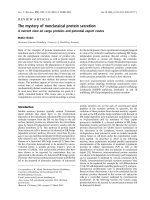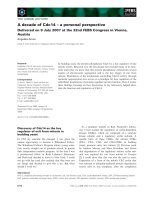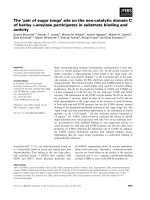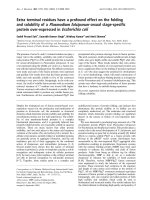Financialization of oil a geographical perspective on oil trading and production
Bạn đang xem bản rút gọn của tài liệu. Xem và tải ngay bản đầy đủ của tài liệu tại đây (2.33 MB, 176 trang )
FINANCIALIZATION OF OIL:
A GEOGRAPHICAL PERSPECTIVE ON
OIL TRADING AND PRODUCTION
NG LI NA
(B. Soc. Sci. (Hons.)), NUS
A THESIS SUBMITTED FOR
THE DEGREE OF MASTER OF SOCIAL SCIENCES
DEPARTMENT OF GEOGRAPHY
NATIONAL UNIVERSITY OF SINGAPORE
2010
ACKNOWLEDGEMENTS
This thesis has materialized, as other commodities would, with the support of
many people throughout its production process. Indeed, no amount of thankyous would suffice in expressing my deepest appreciation to all who have
impacted on this dissertation and my academic journey. However, I remain
extremely thankful for this page. This page, positioned right at the start (i.e.
front), acknowledges the vital contributions of many that have enabled the critical
beginning and developments of my research. In completion of this thesis and the
culmination of my intellectual endeavours in NUS, I would like to express my
sincere heartfelt thanks and gratitude to the following people:
I am extremely honoured to have worked under the supervision of Prof Henry
Yeung. Thank you so much for your guidance, encouragement and your
belief in me and my work. Till today, I struggle to address you by your first
name even after you have requested for graduate students to do so. You are
my teacher, a great mentor and a successful researcher whom I deeply and
dearly respect. I have learnt a lot from you and I am truly grateful for your
time and dedication as my supervisor for my Masters. Thank you!
All my respondents for their valuable time and patience in sharing their
knowledge and insights with me.
Special thanks to Mr. Al Troner, Mr. James Tham, Mr. John Knight and Ms.
Julie Teo S.C. who all extended their generous time and support to this
thesis and myself.
A big thank you to the faculty members of the Department of Geography,
NUS, who made (and still making) Geography a fabulous discipline
through my undergraduate and post-graduate years. In particular, A/P Tim
Bunnell, Prof Lily Kong, Dr. Lisa Law, Dr. Linda Malam, A/P Natalie Oswin,
A/P Victor Savage, Prof. James Sidaway and Prof. Brenda Yeoh for all their
invaluable teachings and kind encouragements.
The excellent support of the administrative staff at the Department who has
been extremely understanding always. Loads of thank-yous to Pauline for
her kind attention to all administrative matters and stress-relieving chit-chats.
The faculty and staff members of the University Scholars Programme,
especially Dr. Lo Mun Hou and Dr. Yew Kong Leong who have broadened
my academic horizons during my undergraduate years.
i
My two markers whose time, critiques and insights on this thesis are deeply
appreciated.
All my friends whom I have met and learnt a lot from in Geography,
especially Songguang and Chih Yuan, Honours classmates [Jacqueline,
Syaifullah, Weijian, Shuping, Xiaohui, Daryl and Simone] and fellow postgraduates [Jiajie, Fred, Deborah, Serene, Jianhao, Aidan, Liu Yi, Chen Rui,
Liu Song, Rana, Xiao Lu, Lishan, November, Kanchan and Diganta].
Thank you all for sharing those moments of laughter, tears and
complaints and making academic life “happen(ing)” as it should be.
My dearest friends especially the Biz Ad gang [Chamila, Sujen and Wan‟er],
Huixia and the rest of the JC pals and Daphne. Thank you all so much for
being there all these while with caring and encouraging SMSes, phone calls
and get-togethers.
Lastly, I dedicate this thesis to Daddy, Mummy and Glenn who have
sacrificed so much taking care of me and accepting me for who I am all
these years.
ii
TABLE OF CONTENTS
Page
Acknowledgements
i
Table of contents
iii
Summary
vii
List of Tables
ix
List of Figures
x
CHAPTER ONE: INTRODUCTION
1.1 Introduction: The US$ 147 oil indictment: Fundamental demand-supply 1
and the financialization of oil
1.2 A financial geographical perspective on oil trading and production
5
1.3 Organization of Thesis
11
CHAPTER TWO: GEOGRAPHY OF FINANCE AND COMMODITIESLITERATURE REVIEW AND CONCEPTUAL FRAMEWORK
2.1 Introduction
12
2.2 Geographies of finance: A critical review
13
2.3 Geographical research on commodities: A critical exposition
22
2.4 Uncovering the nexus of finance and commodity production: a
sympathetic critique of the existing literature
29
2.5 Conceptualizing oil trading: Expounding the significance of finance
in global production networks
32
2.5.1 Unpacking the dynamic processes of the oil GPN–from
production to trade
33
iii
2.5.2 Interdependence in the GPN of oil
39
2.5.3 Grounding interdependence: Power, embeddedness and
value creation in oil trading
42
2.6 Concluding comments
47
CHAPTER THREE: RESEARCH METHODLOGIES
3.1 Introduction
48
3.2 Negotiating the „field‟: Networked connections, trust and power
49
3.3 Field techniques
52
3.3.1 Semi structured interviews
53
3.3.2 Corporate events: Seminars and training session
58
3.3.3 Discourse and textual analysis
59
3.4 Concluding comments
60
CHAPTER FOUR: GEOGRAPHY AND NETWORKED NEGOTIATIONS:
OIL PRODUCTION, TRADING AND BENCHMARK PRICES
4.1 Introduction
62
4.2 Geographies of oil production: From crude oil to refined oil products
63
4.3 Geographies of trading of material oil and benchmark pricing
67
4.3.1 Trading of material oil in Singapore: Spatiality and networked
negotiations
70
4.3.2 The role of Platts: Circulation of market information and
benchmark pricing in Singapore
73
4.4 Concluding comments
82
iv
CHAPTER FIVE: UNCOVERING FINANCE IN THE GPN OF OIL:
‘THE END OF GEOGRAPHY’ OR GROUNDED INTERDEPENDENCE?
5.1 Introduction
84
5.2 Financing, financial oil trading and the financial market for oil
85
5.3 Hedging through oil derivative trading: Socio-spatial negotiations of
exchanges and OTC transactions
88
5.3.1 Organized exchanges: The prevalence of CME and ICE
92
5.3.2 Over The Counter [OTC]: Networked negotiations and the
advent of exchange clearing
96
5.4 Concluding comments
101
CHAPTER SIX: FINANCE AND SPECULATIONS: RE-VISITING THE
SOCIO-SPATIAL NEGOTIATIONS OF OIL TRADING AND
PRODUCTION
6.1 Introduction
103
6.2 Financialization of oil beyond hedging: Geographies of investment
funds and hedge funds
105
6.3 The 2008 oil spike: The performativity of oil derivatives in the sociospatial dynamics of oil trading and production
108
6.4 Concluding comments
116
CHAPTER SEVEN: SUMMARY AND CONCLUSION
7.1 Summary
117
7.2 Implications of Study and Future Research
120
7.3 Concluding comments
124
v
LIST OF REFERENCES
126
APPENDIX I
163
APPENDIX II
164
vi
SUMMARY
As oil prices began to escalate and skyrocket to a historical high of
US$147 per barrel in July 2008, attempts to ascertain whether speculation or
fundamental demand-supply imbalances became a focal point of contention in the
media. This thesis seeks to shed light on this debate by examining the sociospatial dynamics of oil trading. Oil trading involves both the trading of material
oil and oil derivatives. The trading of oil derivatives, predicated on the
financialization of oil, is a critical process that involves hedging against price
risk exposures incurred in the trading and production of oil. However, the
financialization of oil has led to the development of speculative activities such
as investment and hedge funds that have been noted to contribute to speculative
trading. To understand the significance and impacts of the financialization of oil
on trading, production and prices of oil, this thesis proceeds to analyze the
processes and actors involved in the risk management and value creation of the
global oil industry.
As much as the trading and production of oil are dependent on oil
derivative trading for price risk management, the process of oil derivative trading
and financial services as a whole are, in turn, sustained by the needs of the oil
industry. I propose how interdependence between these processes is deeply
embedded within socio-spatial relations, information and knowledge networks
and also grounded in distinct geographical locations such as Singapore.
vii
Furthermore, I proffer that oil prices should be fundamentally understood as
influenced by mutual adjustments and effects, i.e. the interdependence, of both oil
derivative trading and the trading and production of material oil. This research
marks a humble contribution to the on-going academic perforations into the
“black box of finance” (MacKenzie 2005) by examining the significance of
finance within commodity production beyond the provision of credit loans to
businesses and revealing how the separate fields of finance and commodities,
more specifically commodity production, in economic geography do in fact
intertwine.
Keywords: Financialization, global production networks (GPN), Derivatives, Oil
trading, Singapore
viii
LIST OF TABLES
Page
Table 1.1 Comparision between NYMEX futures volume and global
exports and imports in 2008
3
Table 3.1 Field notes and reflections
49
Table 3.2 Profile of semi-structured interview respondents
54
Table 3.3 Corporate events attended
58
Table 4.1 Key geographies of production and corresponding major oil
Firms
64
Table 4.2 World‟s largest refineries and corresponding locations
65
Table 4.3 Partial listing of firms involved in oil trading based in Singapore
71
Table 4.4 Major market players ( ≥ 3% participation by trade volume)
in various crude and refined products MOC [from Jan-Jul 2009]
78
ix
LIST OF FIGURES
Page
Fig. 2.1 A conceptualization oil networks and their relations with oil
derivative trading
36
Fig. 2.2 Example of a generic netchain (Lazzarini et al. 2001 pp. 8)
40
Fig. 4.1 World proven crude oil reserves (end of 2008)
64
Fig. 4.2 Map of major trade movements of oil
65
Fig. 4.3 Map of major spot markets and benchmark zones
68
Fig. 6.1 The performativity of economics: a possible classification
(MacKenzie 2006b:17)
111
x
CHAPTER ONE: INTRODUCTION
1.1
Introduction: The US$ 147 oil indictment: Fundamental demandsupply and the financialization of oil
As oil prices began to soar in early 2008, the rising oil prices have begun
to hurt Singapore car drivers at the petrol pump, just as they are causing
corporate costs around the globe to skyrocket as well. Indeed, oil underlies the
economic metabolism of most countries in the world. As oil prices continue to
escalate, the pressing question remains how high would oil prices go (The Straits
Times 29/04/2008). In the midst of rife conjectures on oil price movements, oil
price projections went through the roof with the Wall Street titan, Goldman Sachs
Group Inc. predicting that oil prices would hit a high of US$150 to US$200 per
barrel from 2008 to 2010. These steep prices were noted to be perpetuated by
Asian, specifically China‟s economic development and increasing high
consumption in preparations for the 2008 Olympic games. Oil supplies were
reported being threatened by political and social unrest in the major oilproducing countries of Nigeria, Venezuela, Iraq and Mexico. Furthermore,
falling U.S. dollars to which oil was a natural hedge against inflation also
drove oil prices upwards (Bloomberg News 06/05/2008). Adding to the blustery
of high oil prices is the notion of speculative trading. At the World Petroleum
Congress on 30 June 2008 in Madrid, oil ministers of Saudi Arabia and Qatar
blamed speculative activities in the oil markets to cause oil prices to surge beyond
US$140 per barrel. This was refuted promptly by top representatives of oil
majors such as Shell and BP who claimed that steep oil prices were
1
fundamentally led by demand and supply imbalances (Platts Oilgram Price
Report 01/07/2008). As oil prices hit US$147 per barrel for the first time in
history in July 2008, the clamour on whether demand-supply fundamentals or
speculative activities had caused the oil price spike amplified.
Within these discourses, there is an inherent difference in the
spatial inflection between fundamental oil demand-supply and that of speculative
activities. The demand-supply of oil dynamics that are often understood to be
grounded in countries; whether the volume of oil produced and consumed by
specific countries have caused demand-supply imbalances. Speculative activities,
on the other hand, are marked by difficulties in grounding apparently invisible
global investment and capital flows mediated through financial institutions such
as investment banks, asset management firms and hedge funds. The ability to
identify spatial locations of production and consumption of oil provides a
concrete and
material
basis, as
compared
to speculative activities, in
understanding the reasons behind oil price fluctuations. Although the
determinants of oil price movements have much to do with perceptions about
current and future demand and supply balances, they are also influenced by
investor‟s optimization of returns from their portfolios of diverse financial
instruments. This financial motive can be seen in how as Dan Gilligan, president
of Petroleum Marketers Association, declared that (CBS news 60 minutes):
2
Approximately 60 to 70 percent of the oil contracts in the futures
markets are now held by speculative entities. Not by companies that
need oil, not by the airlines, not by the oil companies. But by investors
that are looking to make money from their speculative positions.
Table 1.1 compares the data on the global trade movements of oil in 2008
(i.e. crude and refined oil products exports and imports) which registered at
54,626,000 barrels per day to the volume of three main oil futures contracts traded
on the New York Mercantile Exchange (NYMEX). The latter alone stands at
690,829,000 barrels per day. The trading transactions of oil futures contract have
clearly outstripped the volume of material oil exported and imported globally by
more than ten folds. Hence, rather than to fulfill consumptive needs, the trading
of these futures contracts are likely underlined by speculative trading in search
of greater financial gains.
Table 1.1 Comparision between NYMEX futures volume and global exports
and imports in 2008
NYMEX Product
Light Sweet Crude Futures
Heating Oil Futures
New York Harbor RBOB
Gasoline Futures
NYMEX futures Total
Total Global Exports and
Imports
Contract
volume
(daily average)
532,309
77,403
81,117
Minimum
trading units per
contract (barrels)
1,000
1,000
1,000
Total no. of
barrels traded
(daily ave.)
482,246, 000
77,403,000
81,117,000
690829
-
1,000
-
690,829,000
54,626, 000
Data sources: BP Statistical Review of World Energy June 2009 / NYMEX (CME)
In this thesis, speculation is founded within the trading of oil derivatives
or simply paper oil1. The pertinence of speculation has become very much a part
1
Paper oil is a common term used by traders that refers to paper contracts as per oil derivatives.
3
of oil trading and production and in affecting oil prices. Hence, with oil
derivatives, the process of oil trading and production in the global oil industry has
become more complex. This is especially so as prices from the trading of oil
derivatives such as oil swaps do affect benchmark prices that are widely used to
price material crude oil and refined oil products. As such, the complex processes
and activities of the financialization of oil have been noted to “defy attempts to
seek transparency and appropriate understanding” (Mabro 2006:20).
Rather than to seek complete “transparency”, attempts in analyzing the
dynamics of oil trading and production, would uncover some critical grounded
insights on the oil industry and market.
It is thus central to this thesis to
elucidate the financialization of oil, as per oil derivative trading and speculative
activities, by uncovering the actors and processes involved in the risk management
and value creation of the global oil industry2 in Singapore. Singapore lies
strategically in the global oil shipping and trading routes. This favourable
geography has enabled large flows of transhipment and bulk breaking of oil
cargoes that pass through Singapore. Two of the world‟s largest refineries that are
owned by integrated oil companies, Shell and Exxon-Mobil are located in
Singapore‟s offshore islands. Oil trading in Singapore is well supported by the
presence of established financial services, government schemes and tax breaks
2
The global oil industry is basically delineated by three components: Upstream activities include exploration,
acquisition, drilling, developing and producing oil and gas (i.e. exploration and production operations).
Midstream activities are usually denoted by storage and transportation. Downstream activities are marked by
refining, processing, marketing and distribution.
4
offered to traders who operate in its shores. Singapore also hosts the Platts
benchmark price assessment that facilitates the determination of oil prices in the
Asian region (Hong 2007). Many oil firms and corporate oil personnel are located
in Singapore because its environment is conducive for oil trading and
production businesses. This has given rise to a concentration of oil firms and
also an established community of oil traders in Singapore. Furthermore, being
located near to the demand markets of Southeast Asia, oil firms in Singapore are
able to extend their businesses to the region as well. In all, Singapore‟s strategic
location marks a befitting location for the study of the socio-spatial negotiations
of oil derivative trading, speculative activities and the trading and production of
material oil3.
1.2 A financial geographical perspective on oil trading and production
On a broad level, this thesis seeks to contribute to the on-going academic
perforations into the “black box of finance” (MacKenzie 2005) by understanding
how finance is situated within commodity production beyond simply financing
businesses. This approach draws together two separate but yet conjoined fields of
study of commodities, more specifically commodity production, and finance in
economic geography. As much as finance is itself an industry with distinct sociospatial negotiations grounded in global financial centres and cities such as New
York, London, Tokyo, Hong Kong and Singapore (see Sassen 2002), its function
and system remains fundamentally to provide financial services to users who
3
The term „material oil‟ refers to oil that is tangible and can be metabolized. In many of the interview
quotations used throughout this thesis, the term „physical‟ (widely used in the oil industry) refers to oil in its
real, material form.
5
require them. Hence, finance would be essentially embodied within other
socio-economic processes such as production. Coe et al. (2008:275) have
highlighted how finance is one of the “constituent parts of the overall production
system”. Not only is finance a critical part of production, finance and the
process of financialization are in fact sustained by the structure and strategies of
global production (Milberg 2008).
This thesis thus seeks primarily to contribute to the burgeoning literature
on finance and commodity in economic geography by examining the socio-spatial
negotiations of finance within the process of commodity production. This is the
financial geographical perspective that I will adopt in accounting for the complex
and interwoven geographies of oil as both a material and also paper-traded
commodity. As networks have become “the foundational unit of analysis for our
understanding of the global economy, not individuals, firms or nation states”
(Dicken et al 2001:91), the process of oil trading will be analyzed on the basis of
a network approach,
specifically the global production network (GPN)
framework, in explicating the linkages and power relations involved in the
process of oil trading.
The GPN approach, rooted in network ontology, has the capacity to
incorporate a wide spectrum of actors, processes and geographies in engendering
a comprehensive study of the sites that constitute production across the world.
The GPN of oil has in fact been addressed by Bridge (2008a) who
specifically analyzed the geographies of oil production from upstream extraction
of crude to downstream refining operations and also that of oil consumption.
6
However, the process of oil trading, a central circulatory process that underlies
these sites of production, remains obscure. The process of oil trading is
delineated by two processes: the trading of material oil and trading of oil
derivatives. The trading of material oil marks the buying and selling and the
movement of oil cargoes upon settlement of trade transactions. This process is
situated and mediated through specific sites of embedded networks such as
that of
Singapore and also proximity to other locations so as to facilitate
trading decisions and strategies. As noted by Hudson (2008), space is integral
to the biography of commodities, moving across varied sites of production,
exchange and consumption as they flow around the capitalist circuit. With
regards to the process of material oil trading, Singapore marks an important
locus within these circulatory flows. On a similar note, the trading of oil
derivatives, marked by the circulation of paper contracts, also exhibits distinct
localities denoted by the prevalence of organized exchanges (i.e. Chicago
Mercantile Exchange [CME] and Intercontinental Exchange [ICE]) and also
sites of embedded networks such as Singapore for over-the-counter (OTC)
private bilateral transactions (see Appendix I and II).
To unpack further my key objectives, this thesis seeks to explore how the
GPN approach can be extended to incorporate wider and also underlying
processes such as that of finance, in contributing to “ …the analysis of the spatial
creation, enhancement, and capture of value -- defined as surplus value and
economic rent in different configurations of GPNS” (Hess & Yeung 2006:1200).
7
The financialization of oil involves the trading of oil derivative such as futures,
swaps and options. Oil derivatives are financial contracts that derive their values
and prices from material oil (see Appendix I). These financial contracts are then
traded as would a material commodity. Hence, other than providing credit loans,
finance, integral to the central production operations of the GPN of oil,
involves the process of oil derivative trading. The trading and production of
material oil depends on oil derivative trading for risk management; providing a
hedge against the price risk 4 to which oil cargoes in transit and material oil
produced in the future are exposed to. Conversely, the function of oil derivative
trading is sustained by the need for managing price risk incurred in trading and
production of material oil. Hence, rather than merely acknowledging that finance
is significant to commodity production, the case of oil trading and production
establishes how there is an interdependence between them.
The conscious endeavour of this thesis thus complements one of the recent
research developments in the geography of finance; financialization. As noted by
Engelen (2008), financialization is a concept that has been widely addressed
across different disciplines, embodying different theoretical underpinnings from
structuralist to Marxist political economy to post-structuralist with a cultural slant.
However, underlying these theoretical paradigms is the elucidation of the effects
and impacts of finance on individuals, firms, society and global economy at large.
4
Price risk refers to the “risk of losing money as a result of price movements in the energy markets and is
sometimes referred to as “market risk” (James 2007:2).
8
I pertain that financialization should be understood as a process in which entities
become increasingly integrated into the financial markets. Furthermore, this
study on financialization of oil with regards to commodity production not only
extends beyond understanding how firms or individuals are increasingly
integrated
into
the
financial
world,
but
also
demonstrates
how
financialization is embodied within commodity production as well.
Other than analyzing the interdependence of oil derivative trading and the
trading and production of material oil with regards to risk management and
hedging, the opportunities in gaining cash profits through speculative activities
will be examined as well. Speculation provides liquidity where more actors, who
are willing to buy risks that are sold by others, participate in the trading of oil
derivatives. However, such speculative activities, aimed at value creation as seen
in the financialization of oil as per investment funds and the aggressive oil
derivative trading strategies of hedge funds, have been deemed to occur as a
distinct and „detached‟ process from oil trading and production as a whole. With
regards to MacKenzie‟s (2006a; 2006b) view on the performativity of economics,
the performativity of oil derivatives remains rooted in the trading of oil
derivatives. While the effects of the “performances” through oil derivative trading
have caused oil prices to skyrocket as seen in the 2008 price spike, it remains
difficult to ascertain the intentions of actors, whether they are trading oil
derivatives for risk management purposes or speculating for monetary return.
Thus, the performativity of oil derivatives pertains that oil derivative trading
9
should be understood as a process driven by various intentions that yield
different outcomes. These intentions and outcomes, in turn, affect oil trading and
production as a whole. Hence, oil prices remain essentially influenced by the
mutual adjustments and effects of both oil derivative trading and the trading and
production of material oil. I argue that speculative activities and their
geographies, though distinct from those of price risk management, should be
understood as part of the socio-spatial dynamics of oil trading.
10
1.3
Organization of Thesis
This chapter has provided a general overview of the research aims and
directions of this thesis. Chapter 2 proceeds with a critical review of selected
literature in the geography of finance and commodities and an analytical
framework adapted from Bridge‟s (2008a) GPN of oil. Chapter 3 addresses the
methodological issues and reflections pertaining to this study, specifically on the
power relations and politics in negotiating the „field‟. Chapter 4 highlights the
production geographies in the global oil industry and uncovers the socio-spatial
negotiations of material oil trading, specifically in the light of Singapore‟s Platts
benchmark prices that are influenced by both the trading of material oil and oil
derivatives. This chapter is followed by a critical analysis of the spatiality of oil
derivative trading and its interdependence on the trading and production of
material oil in Chapter 5. Speculative activities and their influence on oil prices,
though marked by distinct geographies, reveal a need to ground them more
concretely in the socio-spatial dynamics of oil trading and production as a whole.
This analytical task is the main preoccupation of Chapter 6. Finally, Chapter 7
reviews and summarizes my geographical analysis of the dynamics of oil trading
and production, evaluating the potential of economic geographical research in
engendering a more comprehensive understanding of both financial and
production processes.
11
CHAPTER TWO: GEOGRAPHY OF FINANCE AND COMMODITIESLITERATURE REVIEW AND CONCEPTUAL FRAMEWORK
2.1 Introduction
This chapter evaluates the contemporary geographical research on finance
and commodities. It proceeds to highlight the conceptual framework of oil trading
and production that aims to instate the significance of finance as per the process
of oil derivative trading in the GPN of oil. Research on the geographies of finance
has focused on largely financial centres and operations rather than understanding
finance as a „production process‟ that produces financial services and products
(Grote et al 2002) or a service function in the economy. Although recent studies
of financialization have sought to uncover the effects of finance on corporate
management and everyday life, there remains more to be understood on why and
how material assets are financialized and transformed into financial products or
contracts. Geographical research on commodities is predicated on analyzing
commodity production of mainly agro-food and industrial commodities and also
the process of commodification of natural resources and in environmental
management. I suggest how research on commodities can be extended towards
other commodities, such as oil. Oil is a natural resource that undergoes a
production process in becoming refined oil products. Furthermore, oil has been
financialized into oil derivatives that are widely traded in the financial markets.
This presents an avenue to address both finance and commodity concomitantly
and, by doing so, contribute to the understanding of the dynamics of finance and
12
commodity production respectively. In my conceptual framework section, I seek
to assess the socio-spatial interactions and relations between finance, specifically
the process of oil derivative trading and the production and trading of material oil.
This chapter will proceed with Section 2.2 that outlines the major research
trajectories in the geographies of finance. An overview of geographical research
on commodities will ensue in Section 2.3. Section 2.4 provides a critique of both
strands of literature, instating how finance and commodity production can be
researched in tandem. In Section 2.5, I propose that a study of oil trading
conceptualized on the basis of Bridge‟s (2008a) global production network (GPN)
of oil would elucidate the socio-spatial dynamics co-constituted through
commodity production and finance. This approach sheds light on how oil
derivative trading and the trading and production of material oil are not only
interrelated but also interdependent. I seek to account for this interdependence by
unpacking the power relations, embeddedness, value creation and distinct
geographies inherent within the process of oil trading.
2.2 Geographies of finance: A critical review
Finance, with its deep and extensive impacts on modern society, has been
critically researched in contemporary academia. As the significance of distance
and space are diminished by advanced information and communication
technologies in modern global financial operation, geography is deemed to have
become irrelevant, marking “the end of geography” (O‟Brien 1991). On the
contrary, geographical and related social studies on finance have highlighted how
13
location, place and distinct spatial negotiations do matter in the world of finance.
Leyshon (1995; 1997; 1998) in his progress reports provided reviews of the
diverse studies on the geographies of finance and money from the mid to the late
1990s. Money is an integral part of finance; the financial system is central to
management and circulatory flows of money and capital as deeply intertwined
within the “new international monetary system” (Corbridge & Thrift 1994,
Strange 1994, Clark 2005). However, other than money, research on finance has
extended towards investigating on financial regulation and financialization of
firms amongst other issues. The impacts of the recent 2008 global financial and
economic crisis have exposed the existence of deep interconnections and relations
between different spatialities, scales, individual actors and institutions within
global finance (Aalbers 2009, French et al. 2009, Van Hulten & Webber 2009). In
Geography, there are distinct and also various on-going contributions from
economic geographers such as Clark, Leyshon, Grote, Hall and Wójcik that
examine the geographies of finance and the effects of financialization through
political and cultural economy approaches. The significance of geography in
understanding finance can be seen in the following four major areas of research:
financial regulation, financial centre dynamics, performativity and sociality of
finance, and financialization.
14









